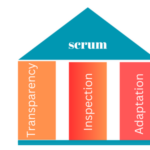
Lean Management with Kanban
Lean Management is a philosophy that aims to eliminate waste and maximize value for customers. It emphasizes the importance of continuous improvement, respect for people, and the pursuit of perfection. Kanban, on the other hand, is a method for managing workflow and visualizing work, originally developed in the context of lean manufacturing.
One example of Lean Management in action is Toyota’s Production System. This system was developed in the 1940s and is widely regarded as the origin of Lean Management. Toyota’s Production System emphasizes continuous improvement, respect for people, and a focus on delivering value to customers. The system incorporates a variety of tools and techniques, including Kanban, to help achieve these goals.
Kanban is a visual management tool that can help teams manage their work more efficiently. One of the key benefits of Kanban is that it limits work in progress, which can help reduce the time it takes to complete tasks and increase overall efficiency. For example, a software development team might use Kanban to manage their work, with tasks moving through the system from “to-do” to “in progress” to “done.” By limiting work in progress, the team can ensure that they are focusing on the most important tasks and completing them as efficiently as possible.
Another benefit of Kanban is that it helps teams identify areas where value is being added or wasted. For example, a manufacturing team might use Kanban to track the movement of materials through their production process. By visualizing the flow of materials and identifying areas of waste, such as excess inventory or unnecessary handling, the team can work to eliminate these inefficiencies and reduce costs.
When used together, Lean Management and Kanban can be a powerful combination for improving efficiency, reducing waste, and delivering value to customers.
By focusing on the principles of continuous improvement, flow, pull, and perfection, and using Kanban as a tool to implement these principles, teams can achieve greater collaboration, efficiency, and customer satisfaction.
5 Principles of Lean Management
1. Value
The first principle of Lean Management is to focus on creating value for the customer. To deliver value, organizations need to understand what the customer considers valuable. This requires a deep understanding of customer needs and preferences, as well as the ability to rapidly respond to changing market conditions. This requires gathering feedback from customers and conducting market research to identify their needs, preferences, and expectations. Once this information has been gathered, organizations can use it to develop products and services that meet these requirements.
Example: Toyota, a leading automobile manufacturer, implemented the Lean philosophy to reduce waste and improve efficiency. They discovered that their customers valued high-quality, affordable cars that were available when they needed them. To deliver this value, Toyota streamlined its production process, minimized waste, and focused on continuous improvement to meet customer needs.
Example: Apple is a company that is well known for its focus on delivering value to its customers. The company has a reputation for producing high-quality products that are innovative, user-friendly, and aesthetically pleasing. Apple achieves this by conducting extensive market research and using customer feedback to inform its product development process.
2. Value Stream
The second principle of Lean Management is analyzing the entire value stream of a product or service, from the initial idea to delivery, and identifying areas for improvement. This principle requires organizations to take a holistic view of their processes and understand how each step in the process contributes to the value delivered to the customer.
To improve the value stream, organizations need to identify and eliminate waste, reduce cycle times, and improve process efficiency. This requires organizations to use tools such as Value Stream Mapping to analyze their processes and identify areas for improvement.
Example: Amazon is a company that has successfully implemented Lean Management principles to optimize its value stream. The company uses a range of tools and techniques to analyze its processes and identify areas for improvement. For example, Amazon uses data analytics to optimize its supply chain and reduce cycle times, allowing the company to deliver products more quickly and efficiently to its customers.
3. Flow
The third principle of Lean Management is creating a smooth and continuous flow of work, minimizing delays and waste in the process. This principle requires organizations to focus on optimizing their processes to ensure that work flows smoothly from one step to the next.
To achieve this, organizations need to eliminate bottlenecks and optimize their workflows. This requires identifying and eliminating waste, reducing cycle times, and improving the efficiency of each step in the process.
Example: Tesla is a company that has focused on optimizing its processes to create a smooth and continuous flow of work. The company has implemented a range of Lean Management principles to optimize its manufacturing processes, including reducing waste, optimizing workflows, and improving cycle times. As a result, Tesla has been able to produce high-quality electric vehicles at scale, meeting the growing demand for sustainable transportation.
4. Pull
The fourth principle of Lean Management is to establish a pull-based system that responds to customer demand in real-time. This involves producing only what the customer wants, when they want it, and in the quantities they require. By minimizing inventory and producing on-demand, organizations can reduce waste and improve efficiency.
Example: Dell, a leading computer manufacturer, has implemented a pull-based system to respond to changing customer demands. Rather than producing large batches of computers and storing them in inventory, Dell produces computers as they are ordered by customers. This has allowed Dell to reduce inventory costs and respond more quickly to changing market conditions.
5. Perfection
The fifth and final principle of Lean Management is to strive for perfection by continuously improving processes and eliminating waste. This involves creating a culture of continuous improvement, where every employee is encouraged to identify and solve problems in order to create a better product or service.
Example: Toyota, one of the pioneers of Lean Management, has created a culture of continuous improvement by empowering employees to identify and solve problems in their daily work. By encouraging all employees to contribute to the improvement process, Toyota has been able to create a culture of innovation and excellence that has made them one of the most successful automobile manufacturers in the world.
Lean Management in Different Domains/Sectors
Manufacturing
One well-known example of Lean Management in action is the Toyota Production System. Toyota implemented Lean Management principles in its manufacturing processes, which helped the company to become one of the most efficient and profitable automobile manufacturers in the world. The Toyota Production System emphasizes continuous improvement, respect for people, and the elimination of waste.
Healthcare
Hospitals and clinics have implemented Lean Management principles to improve patient outcomes and reduce costs. For example, a hospital might use Lean Management to improve patient flow, reduce wait times, and improve the quality of care. By implementing Lean Management principles, hospitals can improve the patient experience and reduce costs, which benefits both patients and healthcare providers.
Software Development
Lean Management principles can also be applied to software development. Agile methodologies such as Scrum and Kanban use Lean Management principles to help teams work more efficiently and deliver better software products. By focusing on eliminating waste and improving efficiency, software development teams can reduce development time, increase product quality, and respond more quickly to changes in customer demand.
Potential Challenges
While Lean Management principles have been proven to be effective in a variety of industries, there can be potential challenges to their implementation. One challenge is resistance to change. Employees may be accustomed to the way things have always been done and may be resistant to changes in their processes and workflows. For example, a company that has been using a particular manufacturing process for years may resist changing to a more efficient process that requires different equipment and training.
Another challenge is the need for ongoing improvement. Lean Management is not a one-time fix, but rather a continuous improvement process that requires ongoing effort and commitment. For example, a company may implement Lean Management principles and see immediate improvements in efficiency and quality. However, if they do not continue to seek out ways to improve their processes, they may stagnate and lose their competitive edge
Benefits of Lean Management
Despite these potential challenges, there are many benefits to implementing Lean Management principles in an organization. Some of these benefits include:
- Increased efficiency: By eliminating waste and streamlining processes, organizations can work more efficiently and deliver products or services more quickly. For example, a company that implements Lean Management principles may be able to reduce the time it takes to manufacture a product, resulting in faster delivery times to customers.
- Improved quality: By focusing on the needs of customers and reducing defects, organizations can improve the quality of their products or services and increase customer satisfaction. For example, a company that implements Lean Management principles may be able to reduce the number of defects in their products, resulting in higher customer satisfaction and fewer returns.
- Reduced costs: By eliminating waste and improving efficiency, organizations can reduce costs associated with production, inventory, and other processes. For example, a company that implements Lean Management principles may be able to reduce its inventory levels and associated carrying costs.
- Improved employee morale: By involving employees in the process of continuous improvement, organizations can improve employee satisfaction and engagement. For example, a company that implements Lean Management principles may solicit feedback and ideas from employees and involve them in identifying areas for improvement.
Case study
Healthcare
A study published in the Journal of Healthcare Management found that a hospital that implemented Lean Management principles saw a 20% reduction in patient wait times, a 30% reduction in length of stay, and a 40% reduction in medication errors.
Manufacturing
A study published in the International Journal of Operations and Production Management found that a manufacturing company that implemented Lean Management principles saw a 32% reduction in lead time, a 65% reduction in inventory levels, and a 35% increase in productivity.
Logistics
A study conducted by the Massachusetts Institute of Technology found that a logistics company that implemented Lean Management principles saw a 50% reduction in order processing time and a 60% reduction in inventory levels.
Service
A study published in the Journal of Service Research found that a service organization that implemented Lean Management principles saw a 23% reduction in service time and a 17% increase in customer satisfaction.
Construction
A study published in the Journal of Construction Engineering and Management found that a construction company that implemented Lean Management principles saw a 17% reduction in project duration and a 16% reduction in project cost.
You may also like:














0 Comments